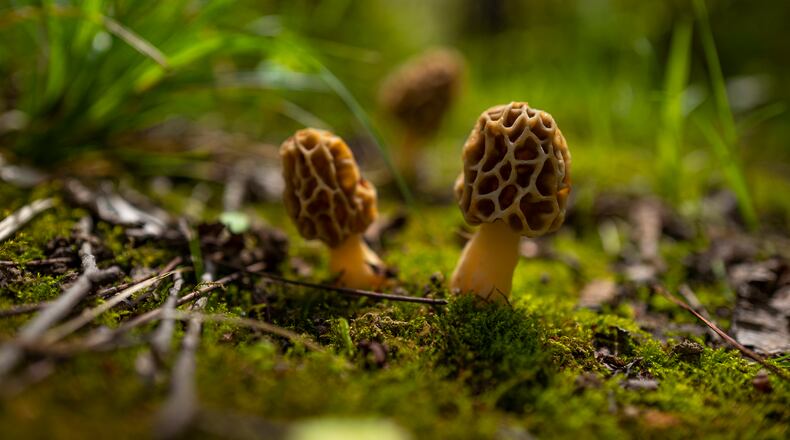Morel mushrooms, properly “Morchella” are fungi that appear in the spring across the northern hemisphere, but especially drive “mushroom hunters” near mad in the Midwest. Trespassing. Camouflage. Cash under the table. Missed work.
All have been attributed to or used in the quest for these fungi. Why?
Because they’re delicious. They’re prized by French and Catalan chefs. Here in SW Ohio, if you’re in the right spot at the right time, they can be plentiful and not too difficult to find. The right place at the right time is the trick. While you might get an experienced morel hunter to help with the timing, don’t expect directions or holding hands to their best spots.
These are some of the most heavily guarded secrets in all of the outdoors.
Wild Ambrosia
The attention morels receive is in part due to their wildness. Attempts to grow them commercially have met with mixed success. They have a complex lifecycle dependent upon the seasons, humidity, temperature, and a symbiotic relationship with their environment.
Some years produce more than others. They’re not predictable. That makes it difficult, if not impossible, to replicate commercially in a controlled environment.
If you want them on your table, you or someone you know will have to find them or pay up: a freshly foraged shipment did show up at the Dorothy Lane Market at a reported price of $79 per pound in 2022.
What to look for and where
Morels are often called “sponges” or “sponge mushrooms” because they look like a natural sponge, in a similar black to grey to brown to yellow color, with a cream-colored stalk. They will be hollow in the middle.
There is a wealth of information on the identification of edible mushrooms including visual guides and apps. Because I’m a “wildlife enthusiast” and not an expert, I’ll leave it to those with that designation for proper identification.
The Ohio DNR, dedicated morels sites, and social media have covered that extensively. I will say it’s not terribly difficult to identify when they’re in your hand.
The hardest part is getting them in your hand.
When to look
April to mid-May is the prime time in SW Ohio. Exactly when during that period largely depends on weather and temperature. Morels can grow in 24-48 hours when the conditions are right, seeming to “pop” overnight. One day there’s nothing, then the next, there they are.
Ideal conditions include a string of days with temperatures in the 50s or warmer, with some moisture and staying above freezing. Some people tie the season to the appearance of dandelions. Others look to the appearance of lilac and cherry blossoms, some to violets and redbuds. The season starts in the southernmost part of the state and works its way north.
The smallest black morels variety appear first and the season ends with the largest more yellowish specimens.
For me personally, talking to someone who recently found some is the biggest confidence boost to start my own searches. Social media platforms and websites such as thegreatmorel.com that track morel sightings are also a boon.
As I write this, morels are being found just across the Ohio River in Kentucky.
Where to look
Morels are where they are. I’ve found them randomly in the backyard multiple times. While you have to get outside and look, in one of my best years, I did spot one from my office window. Nothing inspires the will to look for the next one like finding that first one.
There are, however, many ways to increase your chances and make it feel less random and more purposeful. Dying trees, especially Ash and Hickory, are high on the list of target locations. Abandoned orchards are said to be excellent. Look on both sides of trees, search for decaying matter, and maybe most importantly, look with your eyes and not your legs. Meaning: this isn’t a race. Make sure you look carefully in and around vegetation.
Changing perspective can be helpful. Morels want some sunlight, and some moisture, but not too much of either. As mentioned before, they have a complex life cycle.
Know where you are
If you see a car on the side of the road this time of year, there’s a good chance someone is on the hunt for morels. That doesn’t mean you can just pull over and join them. Privately owned lands require permission from the landowner.
Public lands run the gamut of different rules and regulations. Most city and metro parks, as well as state nature preserves and natural areas are a “no.”
Rules for Ohio State parks vary from park to park but many allow morel hunting. Contact the park office directly to ensure you’re in an allowed location before you go to avoid any headaches - and surrendering any mushrooms you do find.
Ohio State Forests and Wildlife Areas, as well as Wayne National Forest are open to mushroom gathering.
If you’re lucky enough to find some, make sure you rinse and cook them thoroughly. It’s hard to top breaded and sauteed in butter, but there are plenty of recipes available. Enjoy, and see you outside.
About the Author


